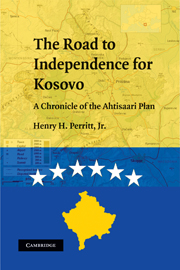Book contents
- Frontmatter
- Contents
- Acknowledgments
- Introduction
- 1 Riots in Kosovo
- 2 Albanian Resentment Comes to a Boil
- 3 Armed Conflict Grows
- 4 Cease-Fire Breaks Down
- 5 Establishing the United Nations' First Colony
- 6 Living Under a Colonial Regime
- 7 Responding to the Wake-Up Call
- 8 The Politics of Purgatory
- 9 Enter Martti Ahtisaari
- 10 The Stage for Final Status
- 11 “Practical” Negotiations
- 12 Negotiations over Status Itself
- 13 The Ahtisaari Plan
- 14 The Plan Runs into Trouble
- 15 The Troika Takes Over
- 16 Independence Day
- 17 Kosovo's Future
- 18 Implications for the International Order
- Glossary of Acronyms
- Bibliography
- Index
9 - Enter Martti Ahtisaari
Published online by Cambridge University Press: 22 January 2010
- Frontmatter
- Contents
- Acknowledgments
- Introduction
- 1 Riots in Kosovo
- 2 Albanian Resentment Comes to a Boil
- 3 Armed Conflict Grows
- 4 Cease-Fire Breaks Down
- 5 Establishing the United Nations' First Colony
- 6 Living Under a Colonial Regime
- 7 Responding to the Wake-Up Call
- 8 The Politics of Purgatory
- 9 Enter Martti Ahtisaari
- 10 The Stage for Final Status
- 11 “Practical” Negotiations
- 12 Negotiations over Status Itself
- 13 The Ahtisaari Plan
- 14 The Plan Runs into Trouble
- 15 The Troika Takes Over
- 16 Independence Day
- 17 Kosovo's Future
- 18 Implications for the International Order
- Glossary of Acronyms
- Bibliography
- Index
Summary
Even as Kai Eide was deciding that Kosovo was ready for final status talks, the process of deciding who should be the special envoy for final status was underway. Several distinguished international diplomats had experienced close contact with Kosovo or Bosnia, and therefore were credible candidates. Eide himself was a candidate, and most inside observers thought he wanted the additional role. His country, however, was not a member of the EU. Other contenders surfaced during the course of 2005, including Giulano Amato, former prime minister of Italy, and George Robertson, former NATO Secretary General. Robertson turned out not to be interested, and Amato was seen as too aggressive in promoting his own candidacy. From early 2005, the two leading candidates were Carl Bildt and former president of Finland Martti Ahtisaari. Bildt was ultimately rejected because of his reputation for being a bull in a china shop, and because the United States mistrusted him, as unpredictable and tied too closely to Belgrade. The United States did not pick a fight with him, but the fact was Bildt was a marginal player in major decisions, and he never really tried to buck the tide.
Martti Ahtisaari was appointed Special Envoy of the Secretary General of the United Nations for the Future Status Process for Kosovo in October 2005. “There were many people who were qualified, in some sense, to guide the final status negotiations,” said one experienced diplomat, “but Martti Ahtisaari was the best of them. Everyone knew him and respected him.
- Type
- Chapter
- Information
- The Road to Independence for KosovoA Chronicle of the Ahtisaari Plan, pp. 111 - 118Publisher: Cambridge University PressPrint publication year: 2009

